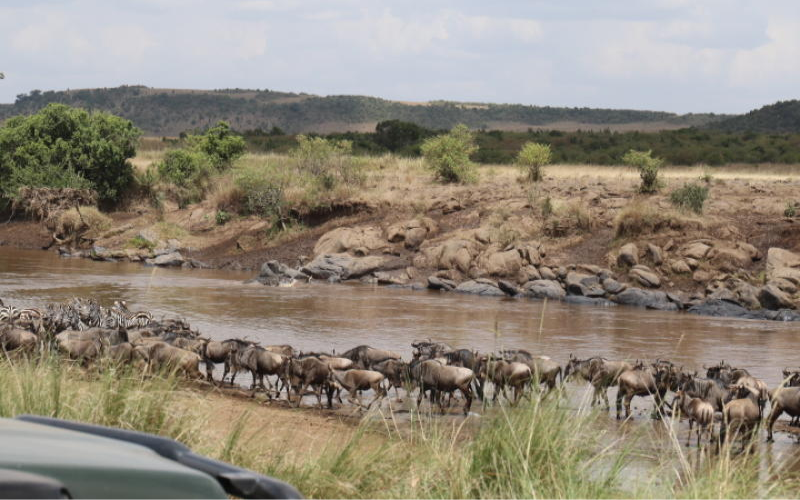Maasai Mara is known for its wildlife viewing experiences, but it is world-famous for one magical event, the wildebeest migration, one of nature’s greatest spectacles.
In it, herds of wildebeest and zebras make their way from Tanzania’s Serengeti into Kenya’s Maasai Mara National Reserve. The migration that starts building up in July and explodes into action in subsequent weeks is poised to begin any time now.
Despite a delay caused by extended rains in Tanzania, tourism operators are gearing up for what is expected to be a record-breaking season.
Thousands of wildebeests are moving fast through Tanzania’s Northern Grumeti and Ikorongo reserves, with the lead groups reportedly nearing the Kichwa Tembo area on the Kenyan side.
Wildlife experts predict the iconic crossing into the Mara could happen at any moment.
“We are closely monitoring the herds from the southern Serengeti,” said Stephen Ole Minis, Chief Park Warden of the Maasai Mara.
“The rains provided plenty of grass, delaying their movement, but the first crossings are expected within days,” he added.
Over 100,000 tourists are expected to flood into the Mara during the July-to-September migration period, which also marks the peak of Kenya’s safari season.
At Ishara Mara Camp, final preparations are complete, with guests already checked in. “We are fully booked for July and August,” said Camp Manager James Ole Pere.
“The herds haven’t arrived yet, but the anticipation alone is part of the experience. Once they begin crossing, it’s going to be spectacular.”
“We have already done spotting of the migration, and we have witnessed big heards of zebra, gazells, and elands who always as an advance party before the big migration,” said Pere.
At Matira Camp, proprietor Antony Tira, said his 15-tent lodge is ready to host a team of international wildlife photographers staying for three months.
“All systems are set. We are fully booked from mid-July and have restocked supplies in anticipation of the migration,” he said.
Veteran guide Joseph Meitamei, who scouts the Mara and Sand River daily, said the atmosphere is electric. “Everyone is on standby — drivers, spotters, photographers. This is our busiest and most important season.”
Local guide Nancy Nalangu added, “There is suspense in the air. Once the herds appear on the horizon, it turns into a show like no other.”
However, the start of the migration comes amid growing tension over rising park fees. Tour operators, hotel owners, and tour companies have criticised both the Narok County Government and the Kenya Wildlife Service (KWS) for increasing entry fees without considering competition from neighboring safari destinations.
Despite the pricing controversy, the ripple effect of the migration is already being felt in satellite towns like Sekenani, Talek, and Oloolaimutia.
Tent maker Alfred Othiambo said his workshop in Sekenani is overwhelmed with orders. “I’m making over 20 canvas tents for different camps,” he said. “I’ve also received bulk orders for seat covers for safari vehicles. Everyone is preparing for the visitors.”
Airbnb-style accommodations are also on the rise in nearby towns, targeting budget-conscious domestic and regional tourists who are priced out of the reserve’s luxury lodges.
Balloon Safari operator Amin Kaluu said tourists, particularly from Asia, are already arriving.
“We have begun daily flights for our guests — mostly of Indian origin—with each one-hour ride costing around $450.”
Meanwhile, efforts by Narok County to attract more visitors are bearing fruit. Governor Patrick Ole Ntutu recently led a promotional tour of the U.S., culminating in a partnership between Narok and the city of San Francisco.
“For the first time, we expect a significant number of tourists from the United States after efforts to explore a sister City partnership with Palo Alto city in San Francisco, California, bore fruit,” Ntutu said. “The city-to-city twinning agreement will help boost arrivals.”
Ntutu, who is also chairing the Council of Governors’ Tourism and Wildlife Committee, added that this year’s wildebeest migration coincides with the humpback whale migration off Kenya’s coast, in areas like Watamu and Lamu.
“We are branding Kenya as the home of twin migrations — the bush and the beach,” he said. “Between July and September, tourists can witness the wonders of both land and sea.”
The migration is often dubbed the Seventh Wonder of the World. It begins with calving in the southern Serengeti between January and March, before the herds move north in search of greener pastures as the dry season sets in.
